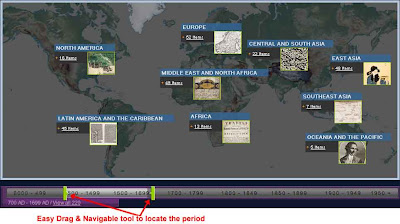The World Digital Library (WDL) makes available on the Internet, free of charge and in multilingual format, significant primary materials from countries and cultures around the world from 8000 BC to 2009 AD and DOWNLOAD them in TIF and other known formats !
Type of Data/Materials Available
- Maps
- Prints, Photographs
- Books
- Manuscripts
- Motion Pictures
- Sound Recordings
The principal objectives of the WDL are to:
- Promote international and intercultural understanding;
- Expand the volume and variety of cultural content on the Internet;
- Provide resources for educators, scholars, and general audiences;
- Build capacity in partner institutions to narrow the digital divide within and between countries.
Easy Drag & Navigable tool to locate the period, identify/select data and download
Topics
History & geography, Earth sciences & geology, Geography & travel, Geology, hydrology & meteorology, Landscape architecture, Historical, geographic & persons treatment, History of Europe, North America, Asia, Middle East & North Africa, Latin America & Caribbean, Africa, Oceania & Pacific, Atlases, maps, charts & plans, Social sciences, Arts & recreation, Religion, Technology, Social groups, Science, Other religions, Social problems & social services, Customs, etiquette & folklore, Agriculture, Architecture, Language, Christianity & Christian theology, Political science, Public administration & military science, Other languages, Plants (Botany), Medicine & health, Landscaping & area planning, Painting, Photography & computer art, Sports, games & entertainment, History of Europe, History of Africa, Creeds & catechisms, Religions of Indic origin, Islam, Babism & Bahai Faith, International relations, General considerations of public administration, Social welfare problems & services, Other social problems & services and many more !
The WDL makes it possible to discover, study, and enjoy cultural treasures from around the world on one site, in a variety of ways. These cultural treasures include, but are not limited to, manuscripts, maps, rare books, musical scores, recordings, films, prints, photographs, and architectural drawings.
Items on the WDL may easily be browsed by place, time, topic, type of item, and contributing institution, or can be located by an open-ended search, in several languages. Special features include interactive geographic clusters, a timeline, advanced image-viewing and interpretive capabilities. Item-level descriptions and interviews with curators about featured items provide additional information.
Navigation tools and content descriptions are provided in Arabic, Chinese, English, French, Portuguese, Russian, and Spanish. Many more languages are represented in the actual books, manuscripts, maps, photographs, and other primary materials, which are provided in their original languages.
The WDL was developed by a team at the U.S. Library of Congress, with contributions by partner institutions in many countries; the support of the United Nations Education, Scientific, and Cultural Organization (UNESCO); and the financial support of a number of companies and private foundations.
Click here to ACCESS The World Digital Library !
OR
Click here to ACCESS The Details and FAQ













 GPWv3 depicts the distribution of human
GPWv3 depicts the distribution of human 









